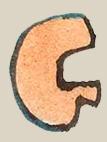tentli (Mdz17v)
This element showing lips (tentli) has been carved from the compound sign for the place name, Chalco Atenco. In that compound the tentli played a phonetic role, but here, isolated as an element, it is a logogram. The lips are expressed as half a face, including the lips (and the lower lip is especially prominent), some of the one cheek that appears (given this is a profile, facing right), and the chin. This partial face has a terracotta skin color.
Stephanie Wood
This glyph for tentli) refers to a location when speaking of landscapes, not literally body parts. Thus, the Atenco part of this place name refers to the location at the edge of the water, i.e. lake.
Stephanie Wood
c. 1541, but by 1553 at the latest
Stephanie Wood
lips, edges, labios, orillas, bordes

ten(tli), lip, edge, https://nahuatl.wired-humanities.org/content/tentli
lip
TEN(TLI)
el labio, la borde, la orilla
Stephanie Wood
Codex Mendoza, folio 17 verso, https://digital.bodleian.ox.ac.uk/objects/2fea788e-2aa2-4f08-b6d9-648c00..., image 45 of 188.
The Bodleian Libraries, University of Oxford, hold the original manuscript, the MS. Arch. Selden. A. 1. This image is published here under the UK Creative Commons, “Attribution-NonCommercial-ShareAlike 3.0 License” (CC-BY-NC-SA 3.0).




